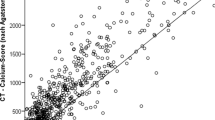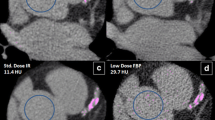Abstract
With the increasing use of coronary artery calcium (CAC) scoring to risk stratify asymptomatic patients for future cardiovascular events, there have been concerns raised regarding the theoretical risk of radiation exposure to this potentially large patient population. Newer CT protocols have sought to reduce radiation exposure without compromising image quality, but the reported radiation exposures in the literature remains widely variable (0.7–10.5 mSv). In this study, we report the radiation exposure of calcium scoring from our MESA cohort across several modern CT scanners with the aim of clarifying the radiation exposure of this imaging modality. To evaluate the mean effective doses of radiation, using dose length product, utilized for coronary artery calcium scoring in the MESA cohort, in an effort to understand estimated population quantity effective dose using individual measurements of scanner radiation output using current CT scanners. We reviewed effective dose in milliSieverts (mSv) for 3442 participants from the MESA cohort undergoing coronary artery calcium scoring, divided over six sites with four different modern CT scanners (Siemens64, Siemens Somatom Definition, GE64, and Toshiba 320). For effective dose calculation (milliSieverts, mSv), we multiplied the dose length product by conversion factor k (0.014). The mean effective dose amongst all participants was 1.05 mSv, a median dose of 0.95 mSV. The mean effective dose ranged from 0.74 to 1.26 across the six centers involved with the MESA cohort. The Siemens Somatom Definition scanner had effective dose of 0.53 (n = 123), Siemens 64 with 0.97 (n = 1684), GE 64 with 1.16 (n = 1219), and Toshiba 320 with 1.26 mSv (n = 416). Subgroup analysis by BMI, age, and gender showed no variability between scanners, gender, ages 45–74 years old, or BMI less than 30 kg/m2. Subjects over age 75 yo had a mean effective dose of 1.29 ± 0.31 mSv, while the <75 yo subgroup was 0.78 ± 0.09 mSv (p < 0.05). Effective doses in subjects with BMI > 40 kg/m2 was significantly greater than other subgroups, with mean dose of 1.47 ± 0.51 mSv (p < 0.01). Using contemporary CT scanners and protocols, the effective dose for coronary artery calcium is approximately 1 mSv, an estimate which is consistently lower than previously reported for CAC scanning, regardless of age, gender, and body mass index.
Similar content being viewed by others
References
Greenland P, Bonow RO, Brundage BH, Budoff MJ, Eisenberg MJ, Grundy SM, Lauer MS, Post WS, Raggi P, Redberg RF, Abrams J, Anderson JL, Bates ER, Eisenberg MJ, Grines CL, Hlatky MA, Lichtenberg RC, Lindner JR, Pohost GM, Schofield RS et al (2007) ACCF/AHA 2007 clinical expert consensus document on coronary artery calcium scoring by computed tomography in global cardiovascular risk assessment and in evaluation of patients with chest pain: a report of the American College of Cardiology Foundation Clinical Expert Consensus Task Force (ACCF/AHA Writing Committee to Update the 2000 Expert Consensus Document on Electron Beam Computed Tomography) developed in collaboration with the Society of Atherosclerosis Imaging and Prevention and the Society of Cardiovascular Computed Tomography. J Am Coll Cardiol 49:378–402
Greenland P, Alpert JS, Beller GA, Benjamin EJ, Budoff MJ, Fayad ZA, Foster E, Hlatky MA, Hodgson JM, Kushner FG, Lauer MS, Shaw LJ, Smith SC Jr, Taylor AJ, Weintraub WS, Wenger NK (2010) 2010 ACCF/AHA guideline for assessment of cardiovascular risk in asymptomatic adults: a report of the american college of cardiology foundation/american heart association task force on practice guidelines. J Am Coll Cardiol 56:50–103
Naghavi M, Falk E, Hecht HS et al (2006) From vulnerable plaque to vulnerable patient—part III: executive summary of the screening for heart attack prevention and education (SHAPE) task force report. Am J Cardiol 98(2A):2H–15H
Stone NJ, Robinson J, Lichtenstein AH, Bairey Merz CN, Blum CB, Eckel RH, Goldberg AC, Gordon D, Levy D, Lloyd-Jones DM, McBride P, Schwartz JS, Shero ST, Smith SC Jr, Watson K, Wilson PWF (2014) ACC/AHA guideline on the treatment of blood cholesterol to reduce atherosclerotic cardiovascular risk in adults: a report of the American College of Cardiology/American Heart Association task force on practice guidelines. J Am Coll Cardiol 63(25 Pt B):2889–2934
Goff DC Jr, Lloyd-Jones DM, Bennett G et al (2013) ACC/AHA guideline on the assessment of cardiovascular risk: a report of the American College of Cardiology/American Heart Association task force on practice guidelines. J Am Coll Cardiol. doi: 10.1016/j.jacc.2013.11.005
Kim KP, Einstein AJ, Berrington de González A (2009) Coronary artery calcification screening: estimated radiation dose and cancer risk. Arch Intern Med 169:1188–1194
Bild DE, Detrano R, Peterson D, Guerci A, Liu K, Shahar E, Ouyang P, Jackson S, Saad MF (2005) Ethnic differences in coronary calcification: the MultiEthnic Study of Atherosclerosis (MESA). Circulation 111:1313–1320
Gerber T, Carr J, Arai A, Dixon R, Ferrari V, Gomes A, Heller G, McCollough C, McNitt-Gray M, Mettler F, Mieres J, Morin R, Yester M (2009) Ionizing radiation in cardiac imaging: a science advisory from the AHA committee on cardiac imaging of the council on clinical cardiology and committee on cardiovascular imaging and intervention of the council on cardiovascular radiology and intervention. Circulation 119(7):1056–1065
Budoff M (2009) Maximizing dose reductions with CT. Int J Cardiovasc Imaging 25:279–287
deGoma EM, Karlsberg RP, Judelson DR, Budoff MJ (2010) The underappreciated impact of heart disease. Womens Health Issues 20(5):299–303
Gerber TC, Gibbons RJ (2010) Weighing the risks and benefits of cardiac imaging with ionizing radiation. JACC Cardiovasc Imaging. 3:528–535
Voros S, Rivera JJ, Berman DS, Blankstein R, Budoff MJ, Cury RC, Desai MY, Dey D, Halliburton SS, Hecht HS, Nasir K, Santos RD, Shapiro MD, Taylor AJ, Valeti US, Young PM, Weissman G (2011) Society for atherosclerosis imaging and prevention tomographic imaging and prevention councils; society of cardiovascular computed tomography. Guideline for minimizing radiation exposure during acquisition of coronary artery calcium scans with the use of multidetector computed tomography: a report by the Society for Atherosclerosis Imaging and Prevention Tomographic Imaging and Prevention Councils in collaboration with the Society of Cardiovascular Computed Tomography. J Cardiovasc Comput Tomogr 5:75–83
Nakazato R, Dey D, Gutstein A, Le ML, Cheng VY, Pimentel R, Paz W, Hayes SW, Thomson LE, Friedman JD, Berman DS (2009) Coronary artery calcium scoring using a reduced tube voltage and radiation dose protocol with dual-source computed tomography. J Cardiovasc Comput Tomogr 3:394–400
McCollough CH, Primak AN, Braun N et al (2009) Strategies for reducing radiation dose in CT. Radiol Clin North Am 47:27–40
McCollough CH, Christner J, Kofler J (2010) How effective is effective dose as a predictor of radiation risk? Am J Roentgenol 194:890–896
Nelson RC, Feuerlein S, Boll DT (2011) New iterative reconstruction techniques for cardiovascular computed tomography: how do they work, and what are the advantages and disadvantages? J Cardiovasc Comput Tomogr 5:286–292
Hunold P et al (2003) Radiation exposure during Cardiac CT: effective doses at multi–detector row CT and electron-beam CT. Radiology 226(1):145–152
Shope TB, Gagne RM, Johnson GC (1981) A method for describing the doses delivered by transmission X-ray computed tomography. Med Phys 8(4):488–495
Acknowledgments
This research was supported by R01 HL071739 and contracts N01-HC-95159 through N01-HC-95165 and N01 HC 95169 from the National Heart, Lung, and Blood Institute and the Multi-Ethnic Study of Atherosclerosis and Air Pollution, funded by the Environmental Protection Agency (EPA) Science to Achieve Results (STAR) Program (grant RD 831697). The authors thank the other investigators, the staff, and the participants of the MESA study for their valuable contributions. A full list of participating MESA investigators and institutions can be found at http://www.mesa-nhlbi.org.
Author information
Authors and Affiliations
Corresponding author
Ethics declarations
Conflict of interest
Matthew Budoff has received research grants from NIH and General Electric. No other author has conflicts of interest.
Ethical approval
All procedures performed in studies involving human participants were in accordance with the ethical standards of the institutional and/or national research committee and with the 1964 Helsinki declaration and its later amendments or comparable ethical standards.
Human and animal studies
This article does not contain any studies with animals performed by any of the authors.
Informed consent
Informed consent was obtained from all individual participants included in the study.
Rights and permissions
About this article
Cite this article
Messenger, B., Li, D., Nasir, K. et al. Coronary calcium scans and radiation exposure in the multi-ethnic study of atherosclerosis. Int J Cardiovasc Imaging 32, 525–529 (2016). https://doi.org/10.1007/s10554-015-0799-3
Received:
Accepted:
Published:
Issue Date:
DOI: https://doi.org/10.1007/s10554-015-0799-3




